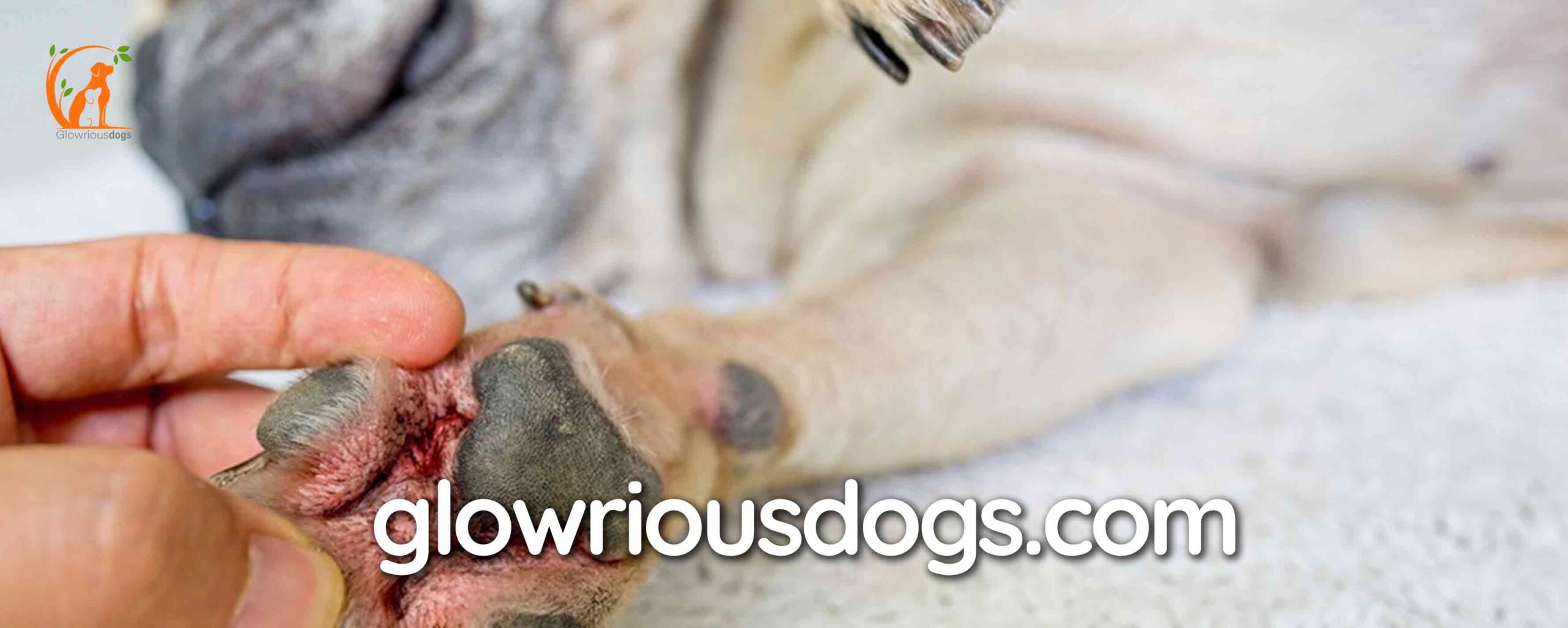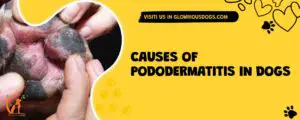To treat pododermatitis in a dog’s paw, try cleaning the affected area thoroughly and applying a topical antibiotic ointment. Regularly monitor the paw for signs of improvement or worsening.
Pododermatitis, also known as interdigital dermatitis, is a common condition that affects a dog’s paw. It can cause discomfort, inflammation, and even infection. If left untreated, it can lead to more serious complications. Fortunately, there are certain steps you can take to treat pododermatitis and alleviate your dog’s discomfort.
We will discuss effective methods for treating pododermatitis in a dog’s paw, including cleaning the affected area and applying a topical antibiotic ointment. By following these steps, you can help improve your dog’s overall paw health and prevent further complications.
Causes Of Pododermatitis In Dogs
- Allergies: Allergies can trigger pododermatitis in dogs. Common allergens include pollen, dust mites, certain foods, and chemicals. Dogs with allergies may lick or chew their paws excessively, leading to inflammation and infection.
- Fungal or Bacterial Infections: Fungal or bacterial infections can affect a dog’s paws, causing pododermatitis. Moist environments, poor hygiene, and weakened immune systems can contribute to the development of these infections. It’s important to promptly address any signs of infection to prevent further complications.
- Trauma or Injury: Dogs may develop pododermatitis as a result of trauma or injury to their paws. This can include cuts, scrapes, burns, or even repeated friction from walking on rough surfaces. Any injury to the paw pads can leave them vulnerable to infection and inflammation.
Determining the underlying cause of pododermatitis is crucial for effective treatment. Consulting with a veterinarian is essential to diagnose the specific cause and develop a tailored treatment plan for your dog.
Recognizing Symptoms Of Pododermatitis
Pododermatitis, also known as inflamed paws, can cause discomfort and pain to your furry friend. Recognizing the symptoms is crucial for early detection and proper treatment. One of the telltale signs is excessive licking or chewing of the paws. If you notice this behavior, it’s important to examine your dog’s paw pads for redness or inflammation. Another symptom to be mindful of is a bad odor or discharge coming from the paws.
If you suspect your dog may be suffering from pododermatitis, it’s best to consult with a veterinarian. They can assess the severity of the condition and provide the appropriate treatment plan, which may include topical medications, antibiotics, or bandaging to promote healing. Additionally, your vet may recommend changes in your dog’s diet or environmental factors to prevent recurrence.
Regular paw care and hygiene are essential in preventing pododermatitis. Cleaning paws after walks, ensuring proper grooming, and providing a comfortable and clean environment are crucial to keeping your furry friend’s paws healthy and happy.
Diagnosing Pododermatitis
Physical examination by a veterinarian: A thorough physical examination by a veterinarian is crucial in diagnosing pododermatitis in dogs. The vet will carefully examine the affected paw, looking for any visible signs of inflammation, redness, swelling, or discharge. They may also check for any abnormalities or injuries that could be causing the condition.
Skin scraping or biopsy: Skin scraping or biopsy may be performed to confirm the diagnosis of pododermatitis. A small sample of the affected skin may be taken and examined under a microscope to look for any signs of infection, inflammation, or underlying skin conditions.
Allergy testing: Allergy testing may be recommended if the veterinarian suspects that your dog’s pododermatitis is due to an allergic reaction. This may involve patch testing or blood tests to identify specific allergens that may be triggering the condition.
By using these diagnostic methods, veterinarians can accurately diagnose and determine the appropriate treatment for pododermatitis in dogs.
Treating Pododermatitis At Home
- Regular paw cleaning: Ensure you clean your dog’s paws on a regular basis.
- Using mild soap and warm water: Gently cleanse the paws with a mild soap and warm water.
- Drying paws thoroughly: After cleaning, make sure to dry the paws completely.
- Applying topical treatments: Consider using antifungal creams or ointments, antibacterial sprays or solutions, or calming/healing balms to aid in the treatment.
- Managing allergies: Address any underlying allergies that may be contributing to the pododermatitis.
- Elimination diet: Consult with a veterinarian to develop an elimination diet to identify any potential food allergies.
- Avoiding contact with allergens: Limit your dog’s exposure to allergens such as grass, pollen, or certain household chemicals if they are known triggers.
Veterinary Treatment Options
When it comes to treating pododermatitis, veterinary treatment options can help provide relief and promote healing. Prescription medications such as oral antibiotics or antifungals may be prescribed to combat any bacterial or fungal infections that may be present. Steroids or immunosuppressants might be used to reduce inflammation and alleviate discomfort. Antihistamines can be given to help manage allergic reactions that may contribute to the condition. In some cases, laser therapy or ultrasound treatment can be effective in promoting tissue repair and reducing inflammation. For severe cases, surgery may be necessary to remove any underlying growths or address deep infections. It is important to consult with a veterinarian to determine the most appropriate treatment plan for your dog’s specific condition.
Prevention And Home Care
Regular grooming and cleaning: Keeping your dog’s paws clean is essential for preventing pododermatitis. Trim the hair around the paw pads regularly to avoid matting and accumulation of dirt. Clean their paws with a damp cloth after outdoor activities to remove any foreign objects.
Providing a clean and hygienic environment: Ensure that your dog’s living area is clean and free from any harmful bacteria or irritants. Regularly wash their bedding and disinfect their living space to minimize the risk of infection.
Maintaining a balanced diet and weight: A proper diet plays a crucial role in overall health, including paw health. Provide a balanced diet rich in essential nutrients, as deficiencies can weaken the immune system, making your dog more susceptible to infections. Additionally, maintaining an ideal weight helps prevent extra pressure on the paws.
Regular exercise and mental stimulation: Exercise keeps your dog physically fit and mentally stimulated. Regular walks and playtime help promote blood circulation to the paws, keeping them healthy. Mental stimulation activities, such as puzzle toys or training exercises, prevent boredom and stress-related behaviors that can lead to excessive paw licking or chewing.
When To See A Veterinarian
Persistent or worsening symptoms: If your dog’s pododermatitis symptoms persist or worsen despite home treatments, it is important to seek the advice of a veterinarian.
Severe pain or discomfort: If your dog is experiencing severe pain or discomfort associated with pododermatitis, it is crucial to consult a veterinarian for proper diagnosis and treatment.
Difficulty walking or using the affected paw: If your dog is having trouble walking or using the affected paw due to pododermatitis, a veterinarian should be consulted to assess the situation and provide appropriate care.
Conclusion
Treating pododermatitis in dogs requires a comprehensive approach that addresses the underlying causes and provides effective solutions. By following the guidelines mentioned in this blog post, such as keeping the paw clean and dry, using appropriate topical treatments, and seeking veterinary advice, dog owners can help alleviate their furry friends’ discomfort and prevent future occurrences.
Remember, a healthy and happy paw is essential for your dog’s overall well-being.
Frequently Asked Questions Of How To Treat Pododermatitis Dog Paw
How Do You Treat Pododermatitis In Dogs Paws At Home?
To treat pododermatitis in dogs paws at home, start by keeping their paws clean and dry. Avoid walking on rough surfaces and provide soft bedding. Apply a veterinarian-approved cream or ointment to the affected area. If symptoms persist, consult a vet for further treatment.
How Do You Get Rid Of Pododermatitis In Dogs?
To get rid of pododermatitis in dogs, start by keeping their paws clean and dry. Use a mild, pet-safe shampoo and rinse thoroughly. Trim long hair around the paws to prevent moisture buildup. If your dog has a skin infection, consult with a veterinarian for appropriate treatment options.
Will Pododermatitis Go Away On Its Own?
Pododermatitis may not always resolve on its own; it often requires veterinary intervention. Immediate treatment is crucial to prevent complications and promote healing.
How Can I Treat My Dogs Infected Paw At Home?
To treat your dog’s infected paw at home, start by cleaning the area with warm water and mild soap. Apply an antiseptic ointment and cover it with a clean bandage. Monitor the paw for any signs of worsening infection. If the condition doesn’t improve or worsens, consult a veterinarian.











